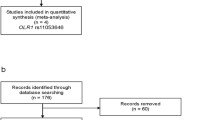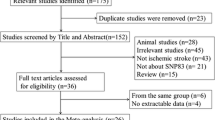Abstract
Cerebrovascular diseases (CVD) are dysfunctions of the brain, resulting from diseases of blood vessels supplying the brain. Atherosclerosis is one of the major underlying causes of CVD, in which inflammation plays a crucial role. One of the inflammatory mechanisms contributing to atherogenesis is the activation of monocytes and macrophages, which could be mediated by the bacterial endotoxin lipopolysaccharide (LPS) via its receptor CD14. The C260T (rs2569190) single-nucleotide polymorphism (SNP) in the promoter region of theCD14 gene was implicated in CVD. To assess the role of this SNP in CVD, a comprehensive meta-analysis of the available genetic data was conducted. All the case-control association studies evaluating the role ofCD14 C260T in CVD were identified. Of these, 7 studies (comprising a total of 1488 patients and 1600 control subjects) were included in this meta-analysis. To measure the strength of genetic association for the gene variant, the odds ratios (ORs) were calculated using both fixed and random effects for comparisons of the alleles, the genotypes, and the dominant and recessive genotype models. The results showed there was no significant association between the T allele of C260T and the risk of CVD under the fixed effects model, OR = 0.99 (95% CI (0.89, 1.09)),P = 0.84; or the random effects model, OR = 0.99 (95% CI (0.88,1.11)),P = 0.83. Similar results were obtained for the homozygotes and the dominant and recessive models. In conclusion, the results of this meta-analysis suggest theCD14 C260T polymorphism is not a risk factor for CVD. However, more studies in ethnically varied populations are needed to evaluate in a reliable manner the role of this SNP in CVD susceptibility.
Similar content being viewed by others

References
Arroyo-Espliguero R, Avanzas P, Jeffery S, Kaski JC, 2004. CD14 and toll-like receptor 4: a link between infection and acute coronary events? Heart 90: 983–988.
Baldini M, Lohman IC, Halonen M, Erickson RP, Holt PG, Martinez FD, 1999. A polymorphism in the 5’ flanking region of theCD14 gene is associated with circulating soluble CD14 levels and with total serum immunoglobulin E. Am J Respir Cell Mol Biol 20: 976–983.
Banerjee I, Gupta V, Ahmed T, Faizaan M, Agarwal P, Ganesh S, 2008. Inflammatory system gene polymorphism and the risk of stroke: a case-control study in an Indian population. Brain Res Bull 75: 158–165.
Begg CB, Mazumdar M, 1994. Operating characteristics of a rank correlation test for publication bias. Biometrics 50: 1088–1101.
Cochran WG, 1954. The combination of estimates from different experiments. Biometrics 10: 101–129.
DerSimonian R, Laird N, 1986. Meta-analysis in clinical trials. Control Clin Trials 7: 177–188.
Egger M, Davey SG, Schneider M, Minder C, 1997. Bias in meta-analysis detected by a simple, graphical test. BMJ 315: 629–634.
Frey EA, Miller DS, Jahr TG, Sundan A, Bazil V, Espevik T, et al. 1992. Soluble CD14 participates in the response of cells to lipopolysaccharide. J Exp Med 176: 1665–1671.
Hansson GK, Robertson AK, Söderberg-Nauclér C, 2006. Inflammation and atherosclerosis. Annu Rev Pathol 1: 297–329.
Hubacek JA, Rothe G, Pit’ha J, Skodová Z, Stanek V, Poledne R, Schmitz G, 1999. C(-260)—>T polymorphism in the promoter of theCD14 monocyte receptor gene as a risk factor for myocardial infarction. Circulation 99: 3218–3220.
Ito D, Murata M, Tanahashi N, Sato H, Sonoda A, Saito I, et al. 2000. Polymorphism in the promoter of lipopolysaccharide receptor CD14 and ischemic cerebrovascular disease. Stroke 31: 2661–2664.
Jawień J, 2008. New insights into immunological aspects of atherosclerosis. Pol Arch Med Wewn 118: 127–131.
Kis Z, Sas K, Gyulai Z, Treso B, Petrovay F, Kapusinszky B, et al. 2007. Chronic infections and genetic factors in the development of ischemic stroke. New Microbiol 30: 213–220.
Lalouschek W, Schillinger M, Hsieh K, Endler G, Greisenegger S, Marculescu R, et al. 2006. Polymorphisms of the inflammatory system and risk of ischemic cerebrovascular events. Clin Chem Lab Med 44: 918–923.
Lichy C, Meiser H, Grond-Ginsbach C, Buggle F, Dörfer C, Grau A, 2002. Lipopolysaccharide receptor CD14 polymorphism and risk of stroke in a South-German population. J Neurol 249: 821–823.
Loppnow H, Stelter F, Schönbeck U, Schlüter C, Ernst M, Schütt C, Flad HD, 1995. Endotoxin activates human vascular smooth muscle cells despite lack of expression of CD14 mRNA or endogenous membrane CD14. Infect Immun 63: 1020–1026.
Mantel N, Haenszel W, 1959. Statistical aspects of the analysis of data from retrospective studies of disease. J Natl Cancer Inst 22: 719–748.
Park MH, Min JY, Koh SB, Kim BJ, Park MK, Park KW, Lee DH, 2006.Helicobacter pylori infection and theCD14 C(-260)T gene polymorphism in ischemic stroke. Thromb Res 118: 671–677.
Schumann RR, Rietschel ET, Loppnow H, 1994. The role of CD14 and lipopolysaccharide-binding protein (LBP) in the activation of different cell types by endotoxin. Med Microbiol Immunol 183: 279–297.
Unkelbach K, Gardemann A, Kostrzewa M, Philipp M, Tillmanns H, Haberbosch W, 1999. A new promoter polymorphism in the gene of lipopolysaccharide receptor CD14 is associated with expired myocardial infarction in patients with low atherosclerotic risk profile. Arterioscler Thromb Vasc Biol 19: 932–938.
Wright SD, Ramos RA, Tobias PS, Ulevitch RJ, Mathison JC, 1990. CD14, a receptor for complexes of lipopolysaccharide (LPS) and LPS-binding protein. Science 249: 1431–1433.
Zee RY, Bates D, Ridker PM, 2002. A prospective evaluation of theCD14 andCD18 gene polymorphisms and risk of stroke. Stroke 33: 892–895.
Author information
Authors and Affiliations
Corresponding author
Rights and permissions
About this article
Cite this article
Banerjee, I. CD14 C260T promoter polymorphism and the risk of cerebrovascular diseases: a meta-analysis. J Appl Genet 50, 153–157 (2009). https://doi.org/10.1007/BF03195667
Received:
Accepted:
Issue Date:
DOI: https://doi.org/10.1007/BF03195667



